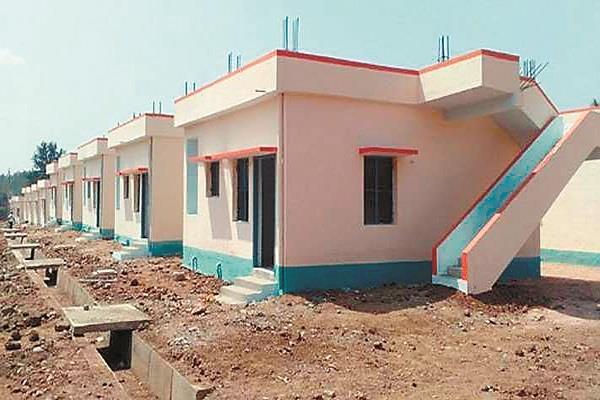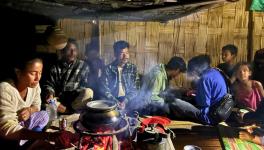Environment: Much-hyped PMAY not to Contribute to India's Cooling Demand Reduction Goals

Image Courtesy: Punjab Kesari
Patna: Contrary to the focus of the Intergovernmental Panel on Climate Change (IPCC) on climate change mitigation, India's much-hyped Pradhan Mantri Awas Yojna (PMAY), the world's biggest housing programme underway, is not building thermally comfortable houses for poor and marginalised people.
This was revealed in the latest State of India's Environment 2022 report by the Centre for Science and Environment (CSE), a New Delhi-based non-profit organisation.
"An assessment by the CSE has revealed that the PMAY is transitioning towards materials that may not be able to contribute to India's cooling demand reduction goals."
The report has made it clear that cooling materials or materials appropriate to the native climate are essential for ensuring resource efficiency, thermal comfort and climate resilience.
"The nation is moving towards pucca structures, but this transition is uninformed and may not be in line with the country's thermal comfort and climate resilience requirements."
The data on materials used to construct pucca houses exposed the seriousness of reducing coupling demand for climate change mitigation. For instance, under the affordable housing in partnership (AHP) vertical of PMAY-Urban, concrete dominates as the walling material, as per the data submitted by different states and Union territories to the PMAY central sanctioning and monitoring committee.
In the sample of 128 projects studied, concrete walls using monolithic cast-in-situ technology and precast technology constitute 53% of all the projects. Under the beneficiaries-led construction vertical of the PMAY-U, RCC frame structures with red bricks form the majority, with 76% of the units using it in a sample size of 115 projects.
Similarly, in 69 projects under the PMAY-Gramin, the majority of the units are load-bearing structures (55%), followed by RCC frame structures (39%) and Ekra walls (6%). The materials in these load-bearing structures were about 55% red bricks, 19% fly ash bricks, 16% sandstone and 5% each laterite blocks and fly ash brick (red brick combination).
The PMAY was launched in 2015 to house every Indian in a pucca home by 2022. Till November 2021, as much as 63% of these new (11.2 million) houses are being built in urban areas. The rural counterpart of the scheme, PMAY-Gramin, has registered about 20.8 million dwelling units, all to be built by the beneficiaries.
However, till last month, as per the Central government's admission, it has sanctioned 1.15 crore houses under PMAY-U (urban), which ends in March 2022.
CSE's report highlighted the need to build thermally comfortable housing stock. As the PMAY is infusing new housing stock in the country, it is crucial that this stock is thermally efficient and improves the quality of life for green recovery in a post-COVID era.
The India Cooling Action Plan aims at reducing cooling demand by 20-25% by the year 2037-38. The recently-held Conference of Parties (COP-26) to the UN Framework Convention on Climate Change in December 2021 in Glasgow has raised the concern of warming in cities and the need for cooling strategies.
"India must not miss out on the opportunity to build thermally comfortable housing stock," the CSE report noted.
According to the report, India is abundant with traditional knowledge on materials that respond to the native climate and reduce any mechanical cooling requirement. The wealth of the traditional knowledge on climate-appropriate housing is mainly passed on from one generation to the other informally.
Integration of knowledge on heat resilient housing involving cool materials and passive architecture with national skulking and livelihood schemes and agencies would be pivotal for giving an impetus to green jobs and green recovery through the housing sector.
There is a demand for sustainable and traditional materials and building techniques. In a public survey conducted by CSE, about 75% of the respondents said they were willing to construct their houses using traditional materials and construction techniques, even if it meant spending extra.
With heatwave conditions sweeping parts of the country since early April, the report suggested adapting and building capacity on traditional knowledge of climate-appropriate material and building methods, tapping available knowledge resources on climate-appropriate and regulating the rampant movement towards modern materials.
In its latest report released on April 4, the IPCC pointed out that in the period 2010-2019, average annual global greenhouse gas emissions were at their highest levels in human history, but the rate of growth has slowed. Without immediate and deep emissions reductions across all sectors, limiting global warming to 1.5°C is beyond reach.
Get the latest reports & analysis with people's perspective on Protests, movements & deep analytical videos, discussions of the current affairs in your Telegram app. Subscribe to NewsClick's Telegram channel & get Real-Time updates on stories, as they get published on our website.
























